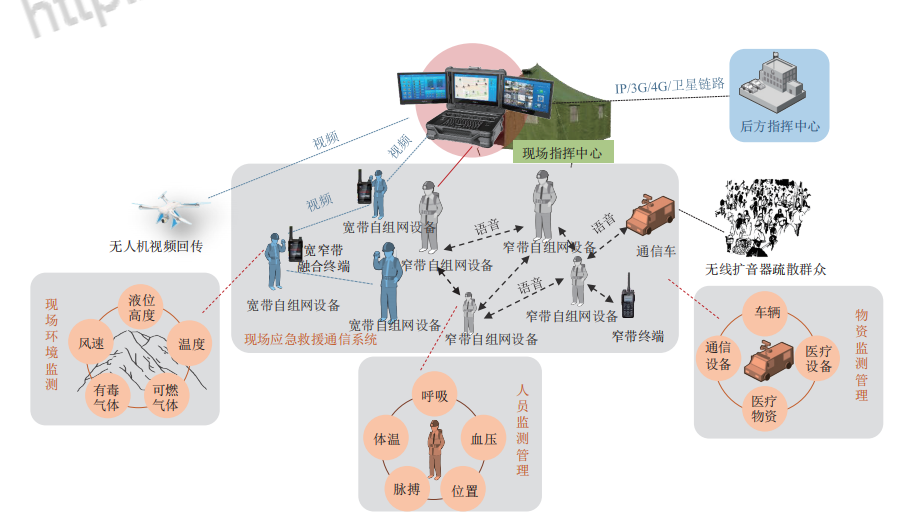Geological disaster rescue scenarios refer to extremely severe scenarios caused by geological environmental disasters that are sudden and destructive, such as earthquakes, mudslides, landslides, etc. In such scenarios, communication infrastructure is usually damaged or even destroyed, and the original communication network faces the risk of long-term paralysis.
Internet of Things applications in geological disaster rescue scenarios generally have the following characteristics:
(1) Disasters are highly destructive and require systems with strong invulnerability;
(2) The site conditions are harsh, requiring the system to have strong environmental adaptability;
(3) There is an urgent need for temporary rapid networking and restoration of communications as soon as possible;
(4) There is an urgent need for on-site integrated command and dispatch such as voice, video, short message, and Internet of Things data.
When the on-site network fails due to a disaster, the P-IoT system can still ensure network availability due to its strong invulnerability. As shown in Figure 3, at the disaster site, with the help of P-IoT and wireless self-organizing network equipment, on-site environmental monitoring data, rescuer monitoring and management data, material monitoring and management data, etc. can be transmitted back to the on-site command center. At the same time, it can also be transmitted through Various links such as public network and satellite transmit data to the rear command center. P-IoT’s monitoring of wind speed, liquid level, toxic gas concentration and other indicators can ensure that commanders fully understand the current situation of on-site disasters. It also helps analyze future disaster trends and provides data assistance for commanders’ judgment and decision-making. P-IoT collects and monitors vital sign data such as breathing, body temperature, and pulse of rescuers, providing life safety protection measures for rescuers working under extremely harsh conditions. Once the P-IoT system detects abnormal alarm information in vital sign data, the system will send alarm information to the rescuers involved and issue evacuation instructions. At the same time, combined with the personnel positioning information, the commander can also mobilize other rescue forces to support and rescue. . P-IoT monitors and manages communications equipment, vehicles, medical equipment and other materials, which helps commanders understand the current use of rescue materials and provides a basis for commanders to carry out subsequent reasonable allocation of resources.

In addition, portable broadband and narrowband self-organizing network equipment can realize the rapid construction of temporary communication and command and dispatch networks at emergency sites. Broadband and narrowband self-organizing network equipment supports independent power supply and does not rely on on-site infrastructure. The portable design ensures that personnel can carry the equipment deep into the rescue site and start the network with one click. After meeting the requirements for rapid recovery of the on-site communication network, the portable on-site command center can realize on-site multimedia visual dispatch and ensure that on-site rescue work can be carried out in an orderly manner during the golden rescue period after the disaster. The location information of rescue personnel and supplies, real-time environmental monitoring information, on-site video information, etc. can be comprehensively displayed on three screens, allowing commanders to control the distribution of manpower and supplies in real time and carry out dynamic dispatch of resources in a timely and reasonable manner. Analysis of on-site data can also assist commanders in predicting secondary disasters and formulating relevant plans in advance. The portable on-site command center supports the transmission of on-site voice, video, and IoT data to the rear command center to form front-to-back linkage command, making it easier for the rear to understand the disaster situation in a timely manner and coordinate rescue forces. The P-IoT broadband and narrowband ad hoc network convergence emergency solution has been used in actual combat many times. For example: In the 2017 Jiuzhaigou earthquake, all communication infrastructure in the earthquake area was paralyzed. The rescue team only deployed 3 narrowband self-organizing network equipment on site to achieve network coverage in the earthquake area, and restored voice communication on site as soon as possible. ; In September 2018, Huizhou, Guangdong suffered floods due to typhoon weather. The local emergency department adopted the P-IoT broadband and narrowband self-organizing network integration emergency solution, which ensured multimedia dispatching of on-site voice, video, and IoT data, and successfully Disaster relief mission completed.
Recommended article: Internet of Things
